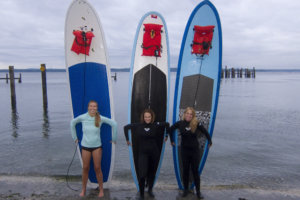Teaching your kid to SUP is a great way to instill a lifelong love of the outdoors and water sports. It’s a safe and healthy activity for children to socialize and make friends. Stand up paddleboarding (SUP) is an ancient form of surfing with a paddle born in Hawaii and has made a huge splash with kids and adults alike. It takes a short learning curve, and you can paddle standing up or kneeling in a bay, ocean, river or lake. Its fun and if will give you a strong body. If you are looking for a new and great way for your kids to explore or just have some fun in the wetter wilderness, this is the sport to try.

From the top of your head to the tip of your toes stand up paddleboarding improves balance, endurance, strength, and coordination. While at it, you may even see schools of fish, turtles, dolphins, and other types of wildlife. Although it is easy for kids and adults to learn, it’s advisable to take lessons to learn the right techniques that allow you to generate power from the arms and upper back. The correct size of paddle and board are important for achieving the best stance.
Kids Standup Paddle Board Safety Guidelines
As a guideline, your child must be at least 8 years old, although there are some six-years-olds who have mastered the art of using the kids paddleboard and some twelve-year-olds who lack adequate coordination to paddle. Therefore, children ought to understand left from right and follow such directions like back “paddle left” or “paddle right.” Instructors should work with parents to identify the right place for the kid to paddle based on weather conditions, traffic on the water, venue and the parent’s knowledge of their kid’s abilities. The kid must know how to swim and have the arm strength to pull a paddle through the water. Ensure the kids can coordinate well to maneuver for steering well. The kid must be well fed and hydrated before embarking on this excursion.
Best Kids Paddleboarding Locations
Choosing the right location when dealing with kids is important to make sure they remain safe and don’t drown. Shallow and calm waters are the best. The following are some advantages and disadvantages of different surfing locations for kids:
In a pool-Most pool are clean and take just a few kids at a time. The kids pools are not too shallow, and you can see what your child is doing. Most of them are treated, and so there are no chances of infection. There are no water-based animals that may scare the kid away. The fact that the kids will miss out on seeing wildlife and nature limits the fun and the ability for the kid to appreciate nature.
On land– It is easier to monitor the kids, and you are sure there is no risk of suffocation or drowning. The only disadvantage is that the child may fall and suffer broken limbs or bruises. There is just something about paddling in water that you can’t get when you are doing it on land.
The lake– There is no perfect place that one can enjoy this sport like a place with lots of water. A lake gives kids a chance to be creative and enjoy both fresh and salt lake waters.
Unless a child is above 12 years or highly experienced, they risk drowning or even death. A lot of parental guidance or instructional care is needed. Kids are not free to exercise creativity and enjoy surfing without being watched by an adult.
The ocean– The Ocean just like a lake gives the child the chance to experience nature at its best so long as they have the right equipment for kids paddleboard. Since there is plenty of water, the kids experience cool waves and can go as deep as they can feel safe. The only downside of paddling in the ocean is that unless the weather is good and the current relaxed, kids risk dying.
In a small pond– Since they are smaller in size, chances of drowning are minimal. To protect fish, most ponds are laced with chemicals which may affect the kids paddleboard. They are also small compared to a lake or ocean so meaning, the kid is limited regarding of how far they can go.
Rivers– Most have clean waters meaning the kids will enjoy the experience. Since there are no chemicals, there is minimal risk for damaging the paddleboard gear. Not many places have rivers hence; the few existing ones might be overcrowded.
Image Credit: Photo 1.